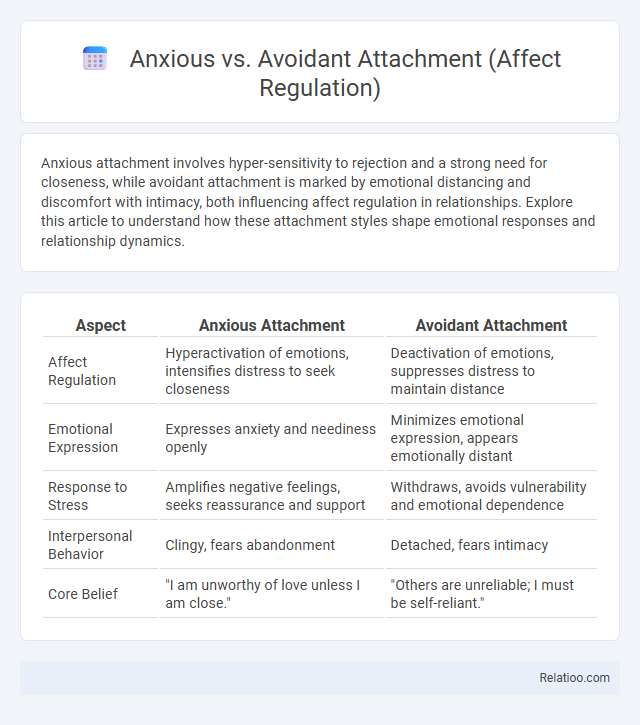Anxious attachment involves hyper-sensitivity to rejection and a strong need for closeness, while avoidant attachment is marked by emotional distancing and discomfort with intimacy, both influencing affect regulation in relationships. Explore this article to understand how these attachment styles shape emotional responses and relationship dynamics.
Table of Comparison
| Aspect | Anxious Attachment | Avoidant Attachment |
|---|---|---|
| Affect Regulation | Hyperactivation of emotions, intensifies distress to seek closeness | Deactivation of emotions, suppresses distress to maintain distance |
| Emotional Expression | Expresses anxiety and neediness openly | Minimizes emotional expression, appears emotionally distant |
| Response to Stress | Amplifies negative feelings, seeks reassurance and support | Withdraws, avoids vulnerability and emotional dependence |
| Interpersonal Behavior | Clingy, fears abandonment | Detached, fears intimacy |
| Core Belief | "I am unworthy of love unless I am close." | "Others are unreliable; I must be self-reliant." |
Understanding Attachment Styles
Understanding anxious vs avoidant attachment styles is crucial for effective affect regulation, as these patterns influence how You manage emotions and stress. Anxious attachment often results in heightened emotional sensitivity and fear of abandonment, while avoidant attachment leads to emotional suppression and discomfort with closeness. Recognizing Your attachment style helps tailor strategies for healthier affect regulation and improved interpersonal relationships.
Defining Anxious Attachment
Anxious attachment is characterized by heightened sensitivity to rejection and a persistent need for reassurance, stemming from inconsistent caregiving during early development. This attachment style leads to difficulties in affect regulation, where individuals struggle to manage emotions and often exhibit hyperactivation strategies to maintain closeness. In contrast, avoidant attachment involves deactivating affect regulation, marked by emotional suppression and distancing behaviors to minimize vulnerability.
Defining Avoidant Attachment
Avoidant attachment is characterized by a reluctance to depend on others or express emotions, often stemming from early caregiver unresponsiveness, leading to emotional suppression and self-reliance. Affect regulation in avoidant individuals involves minimizing emotional expression to maintain distance and control, contrasting with anxious attachment, where heightened emotional expression seeks reassurance. This defensive strategy impacts interpersonal relationships by limiting emotional intimacy and promoting withdrawal during stress or conflict.
Core Differences in Affect Regulation
Anxious attachment involves heightened sensitivity to emotional cues and a strong desire for closeness, leading to hyperactivation of the affect regulation system. Avoidant attachment, in contrast, is characterized by suppression of emotional needs and discomfort with intimacy, resulting in deactivation of affect regulation processes. Your ability to recognize these core differences in affect regulation helps improve emotional awareness and relational patterns.
Emotional Responses in Relationships
Anxious attachment involves heightened emotional responses characterized by fear of abandonment and constant need for reassurance, while avoidant attachment manifests as emotional suppression and distancing to manage discomfort in relationships. Affect regulation in these styles differs significantly; anxious individuals amplify emotional expression to seek closeness, and avoidant individuals minimize or hide emotions to maintain independence. Understanding your attachment style helps improve emotional responses and promotes healthier affect regulation within your relationships.
Coping Mechanisms for Anxiety vs Avoidance
Anxious attachment Coping Mechanisms often involve hypervigilance and seeking reassurance to regulate overwhelming emotions, while Avoidant attachment Coping Mechanisms rely on emotional suppression and withdrawal to maintain distance and control. Affect regulation in Anxious attachment is characterized by heightened emotional sensitivity and efforts to manage fear of abandonment, whereas Avoidant attachment emphasizes detachment and minimization of emotional expression. Effective anxiety management requires tailored strategies: emotional validation and secure connection for Anxious types versus acceptance of vulnerability and gradual emotional engagement for Avoidant individuals.
Impact on Communication Patterns
Anxious attachment often leads to heightened emotional expression and a need for reassurance, causing Your communication to be more urgent and sometimes overwhelming. Avoidant attachment tends to result in emotional distancing and reduced self-disclosure, making interactions appear detached or unresponsive. Affect regulation influences these patterns by determining how emotions are managed and expressed, directly impacting the clarity, responsiveness, and emotional tone in Your communication.
Role of Childhood Experiences
Childhood experiences significantly shape anxious and avoidant attachment styles through their impact on affect regulation, as inconsistent or unresponsive caregiving often leads to heightened emotional distress or suppression in children. Anxious attachment is characterized by hyperactivation of affect regulation systems, resulting in increased sensitivity to emotional cues and fear of abandonment, while avoidant attachment involves deactivation strategies that minimize emotional expression to protect against rejection. These attachment patterns formed in early relationships influence adult emotional regulation capacities and interpersonal behaviors, highlighting the critical role of early caregiver responsiveness in healthy affect regulation development.
Managing Attachment-Related Challenges
Managing attachment-related challenges requires understanding the differences between anxious and avoidant attachment styles in affect regulation. Anxious attachment is characterized by heightened emotional sensitivity and a need for reassurance, while avoidant attachment involves emotional suppression and distance to regulate feelings. Your ability to recognize these patterns empowers you to develop healthier coping mechanisms and improve emotional resilience.
Pathways to Secure Attachment
Anxious attachment is characterized by hyperactivation of affect regulation, leading to heightened emotional sensitivity and a persistent need for reassurance, while avoidant attachment involves deactivation strategies that suppress emotional expression and intimacy. Effective pathways to secure attachment include fostering emotional attunement, consistent responsiveness, and developing reflective functioning that allows individuals to recognize and modulate their internal emotional states. Secure attachment promotes balanced affect regulation, integrating both emotional expression and regulation to build trust and resilience in relationships.

Infographic: Anxious vs Avoidant Attachment (Affect Regulation)
 relatioo.com
relatioo.com